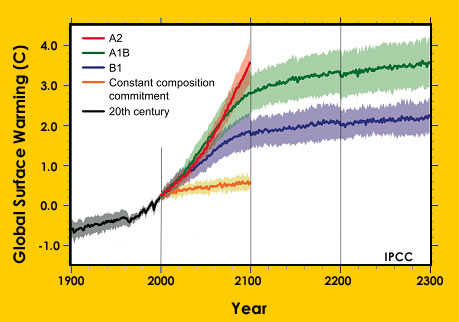Click on image for full size
Courtesy of Dr. Jay Austin, Assistant Professor, Large Lakes Observatory, University of Minnesota, Duluth
Related links:
Changing Planet: The Warming of Our Large Lakes – Reasons for Concern (A Classroom Activity)
Effects of Climate Change Today
Our Changing Planet - Twelve Key Indicators of Climate Change
Earth’s Climate and Global Change
NASA Study Finds Earth's Lakes are Warming
Rising Temperature in Large Lakes
The Earth's climate is warming. That means that air temperature is rising, oceans are warming and large lakes are warming too.A NASA study from November 2010, looked at the surface temperature trends in 167 large lakes worldwide. The study found that lakes around the world are warming - some as much as 1 degree Celsius (1.8 degrees Fahrenheit) per decade.
Now a one degree rise might not seem like a lot in ten years, but it has scientists concerned. One reason for concern is that increased temperatures in lakes means an increase in algal blooms. Algae is naturally found in lake ecosystems and is in fact the base of the food web in lakes. But when the numbers of algae in a lake rise very quickly, a bloom results. Some algal blooms are harmless to life, but are simply unappealing. Water in that area might look terrible, smell foul or even taste bad (when water is drawn for drinking from that source). Other times, algal blooms can be toxic to fish, wild and domestic animals that use that source of water, and humans. Humans can get sick if the toxin is swallowed with lake water or can experience skin irritation if the toxin is touched (like when swimming).
Rising lake temperatures have also been shown to favor invasive species found in lakes. Two examples of invasive species in the Great Lakes are zebra mussels and lampreys. Zebra mussels can live in warmer and warmer waters, which means they can extend their living range to higher and higher latitudes. Lampreys seem to thrive in warmer waters growing bigger and bigger and are staying active for more of the year. Both of these invasive species are extreme pests that are killing off native species. In the case of zebra mussels, they are causing billions of dollars of damage to structures and ships and boats.
NASA was able to survey a large number of lakes all in one study with the help of satellite data. These findings are in line with what is being reported 'on the ground'. Here are three lakes that were included in the study:
1. Lake Baikal - This lake is located in Siberia. It is the largest and oldest freshwater lake in the world. It is in a very remote part of the world. The data from the lake shows that the surface waters have warmed a lot and that the food web in this lake has already experienced changes. Many are concerned that global warming will hurt the 2,500 plant and animal species that make their home in Lake Baikal, including the freshwater seal, found nowhere else in the world.
2. Lake Tanganyika - This lake is located in East Africa. This lake is the warmest it's been in over 1,500 years. Scientists expect that as the lake gets warmer, the number of fish will decline. This is in large part due to increased water stratification that many large lakes are experiencing. Stratification means that there are two layers in the lake. As the surface temperature of the lake gets warmer, those layers will be mixed less and less by wind. That means that valuable nutrients like nitrogen will not be moved from the deep lake to the surface of the lake. Algae will not have nitrogen and other nutrients for food and this in turn hurts the fish population, many who eat algae. An estimated 10 million people live near the Lake Tanganyika, and depend on it for drinking water and food.
3. Lake Superior - This lake is located between the northern U.S. and Canada. It is the deepest, coldest, and largest of the Great Lakes. Many researchers are interested in Lake Superior. One of the ways they study the lake is with buoys like the one shown in the image on this page. The buoys house instruments that measure things like air temperature, water temperature, cloud cover, wind speed and direction. Scientists can access the buoy data from their computers. Scientists say the summer temperatures of Lake Superior jumped 4-4.5 degrees Fahrenheit over the last 30 years. Warming in this lake means increased evaporation of lake waters. Increased evaporation results in lower water levels for the lake overall. Low lake levels affect property owners on lakes, those in the shipping industry, wildlife and plant life too.
Lake Baikal, Lake Tanganyika and Lake Superior aren't isolated cases - global warming affects the temperature of lakes around the world. Many of these lakes are experiencing the undesirable effects of warming such as an increase in algal blooms, the rise of invasive species, decreased numbers of fish and lower lake levels. Obviously, more study is needed for these areas that are home to so many people, animals and plants.















